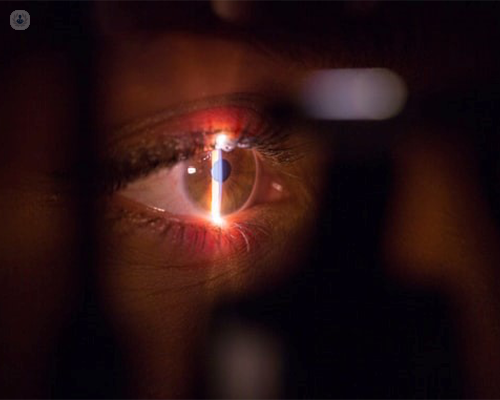YAG laser treatment after cataract surgery
Autore:After cataract surgery, your vision can become cloudy again – a surprising fact for many. This can occur a few weeks after cataract surgery, but most commonly it occurs after many months or years. Mr Bal Manoj, a consultant ophthalmologist and leading specialist in cataracts and YAG treatment, explains why you might need another treatment as well as what to expect when undergoing YAG laser treatment.

YAG laser capsulotomy (the term “capsulotomy” meaning to cut the capsule) is the treatment required to restore clear vision to your eye after a secondary cataract (aka “after cataract”). This is when the membrane at the back of your eye develops a cloudy membrane.
Why do I need another treatment after having cataracts removed?
The back of the eye can develop a cloudy membrane just like the front did before your first cataract treatment. When you received your cataract surgery, the cataract that causes cloudy vision was removed from the capsular bag of your eye and replaced with an artificial lens. To do this, the capsular bag needs to be opened. While the front surface of the capsular bag is opened, the back surface stays in place to support the new artificial lens. In 20% of cataract patients, this back surface starts to opacify, meaning it develops a cloudy membrane over time, just like the cataract did at the front of the eye.
It can occur as soon as a few weeks after cataract surgery, but most commonly it occurs after many months or years. Unlike primary cataracts, secondary cataracts are not associated with ageing. Even children who have undergone cataract surgery can have it.
When should I have YAG laser treatment?
Sometimes, patients notice that their quality of vision is starting to deteriorate and blur again, and they fear that the cataract on their lens is coming back. However, this is impossible because the cataract was removed. YAG laser treatment is only required if your quality of vision negatively affects your general daily activities such as driving and reading.
When an eye specialist evaluates your eye, they will be able to see that the back of the capsular bag has thickened. Even with mild opacity and thickening of the capsule, the quality of vision can be unaffected. In this case, no action is required and eye specialist will keep watch yearly.
How is the YAG laser procedure performed?
YAG treatment is an outpatient procedure, meaning you won’t be required to stay in the clinic overnight. Before the procedure, the ophthalmologist will dilate the pupil by inserting anaesthetic drops that also numb the eye.
It’s a painless procedure and usually takes less than 10 minutes per eye. Unlike cataract surgery, there is no incision in the eye. The entire procedure is done via a laser beam, which is pointed onto the capsule by a surgeon to create an opening. This opening provides a clear path for light to reach the back of the retina, and ultimately, clear up the cloudiness and improve vision to as it was before the secondary cataract.
Are there risks?
The most common side effect is eye floaters (myodesopsia). These look like tiny spots or cobwebs and move around in your field of vision, but they are completely harmless and annoying at most. They will go away in a few weeks but sometimes it can take a few months.
Other risks are rare, such as an increase in eye pressure, retinal detachment and the artificial lens from cataract surgery becoming damaged or displaced. Above all, it’s important to remember that YAG laser treatment is a very safe procedure.
Is there a recovery period?
Recovery from YAG laser treatment is very quick and your vision should continue to improve over the following 24 hours. It’s preferable that you do not drive the same day as your procedure because the dilating drops used can take time to wear off and leave your vision a little blurry. However, the day after treatment you may drive if your vision is clear. You can continue other daily activities the same day if you feel capable but check with your eye specialist if in doubt.
Mr Bal Manoj is highly trained and experienced in all aspects of ophthalmology. View his Top Doctors profile here and book an appointment.



